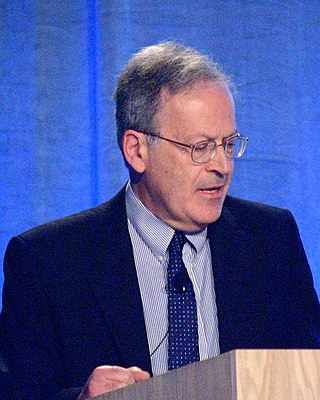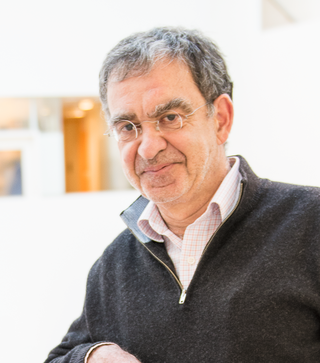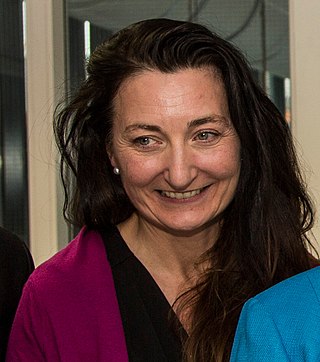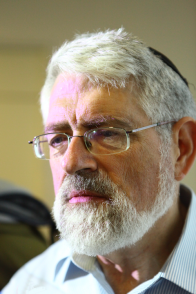Related Research Articles

Neuroscience is the scientific study of the nervous system, its functions and disorders. It is a multidisciplinary science that combines physiology, anatomy, molecular biology, developmental biology, cytology, psychology, physics, computer science, chemistry, medicine, statistics, and mathematical modeling to understand the fundamental and emergent properties of neurons, glia and neural circuits. The understanding of the biological basis of learning, memory, behavior, perception, and consciousness has been described by Eric Kandel as the "epic challenge" of the biological sciences.
Horace Basil Barlow FRS was a British vision scientist.
Terrence Joseph Sejnowski is the Francis Crick Professor at the Salk Institute for Biological Studies where he directs the Computational Neurobiology Laboratory and is the director of the Crick-Jacobs center for theoretical and computational biology. He has performed pioneering research in neural networks and computational neuroscience.
The Society for Neuroscience (SfN) is a professional society, headquartered in Washington, D.C., for basic scientists and physicians around the world whose research is focused on the study of the brain and nervous system. It is especially well known for its annual meeting, consistently one of the largest scientific conferences in the world.

Leslie Gabriel Valiant is a British American computer scientist and computational theorist. He was born to a chemical engineer father and a translator mother. He is currently the T. Jefferson Coolidge Professor of Computer Science and Applied Mathematics at Harvard University. Valiant was awarded the Turing Award in 2010, having been described by the A.C.M. as a heroic figure in theoretical computer science and a role model for his courage and creativity in addressing some of the deepest unsolved problems in science; in particular for his "striking combination of depth and breadth".

The Donald E. Knuth Prize is a prize for outstanding contributions to the foundations of computer science, named after the American computer scientist Donald E. Knuth.

Peter Dayan is a British neuroscientist and computer scientist who is director at the Max Planck Institute for Biological Cybernetics in Tübingen, Germany, along with Ivan De Araujo. He is co-author of Theoretical Neuroscience, an influential textbook on computational neuroscience. He is known for applying Bayesian methods from machine learning and artificial intelligence to understand neural function and is particularly recognized for relating neurotransmitter levels to prediction errors and Bayesian uncertainties. He has pioneered the field of reinforcement learning (RL) where he helped develop the Q-learning algorithm, and made contributions to unsupervised learning, including the wake-sleep algorithm for neural networks and the Helmholtz machine.

Tomaso Armando Poggio, is the Eugene McDermott professor in the Department of Brain and Cognitive Sciences, an investigator at the McGovern Institute for Brain Research, a member of the MIT Computer Science and Artificial Intelligence Laboratory (CSAIL) and director of both the Center for Biological and Computational Learning at MIT and the Center for Brains, Minds, and Machines, a multi-institutional collaboration headquartered at the McGovern Institute since 2013.
The Cognitive Science Society is a professional society for the interdisciplinary field of cognitive science. It brings together researchers from many fields who hold the common goal of understanding the nature of the human mind. The society promotes scientific interchange among researchers in disciplines comprising the field of cognitive science, including artificial intelligence, linguistics, anthropology, psychology, neuroscience, philosophy, and education. The Society is a member of the Federation of Associations in Behavioral & Brain Sciences.

May-Britt Moser is a Norwegian psychologist and neuroscientist, who is a Professor of Psychology and Neuroscience at the Norwegian University of Science and Technology (NTNU). She and her former husband, Edvard Moser, shared half of the 2014 Nobel Prize in Physiology or Medicine, awarded for work concerning the grid cells in the entorhinal cortex, as well as several additional space-representing cell types in the same circuit that make up the positioning system in the brain. Together with Edvard Moser she established the Moser research environment at NTNU, which they lead. Since 2012 she has headed the Centre for Neural Computation.
Jerome "Jerry" Swartz is a physicist that developed early optical strategies for barcode scanning technologies in the United States and co-founded the corporation, Symbol Technologies on Long Island, New York, with physicist partner, Dr. Shelley A. Harrison in 1973. Swartz was President, becoming the Chairman and Chief Scientist in 1982. In 2006 Symbol Technologies became a wholly owned subsidiary of the multinational telecommunications manufacturer, Motorola Corporation.
Nancy Jane Kopell is an American mathematician and professor at Boston University. She is co-director of the Center for Computational Neuroscience and Neural Technology (CompNet). She organized and directs the Cognitive Rhythms Collaborative (CRC). Kopell received her B.A. from Cornell University in 1963 and her Ph.D. from Berkeley in 1967. She held visiting positions at the Centre National de la Recherche Scientifique in France (1970), MIT, and the California Institute of Technology (1976).

William Samuel Bialek is a theoretical biophysicist and a professor at Princeton University and The Graduate Center, CUNY. Much of his work, which has ranged over a wide variety of theoretical problems at the interface of physics and biology, centers around whether various functions of living beings are optimal, and whether a precise quantification of their performance approaches limits set by basic physical principles. Best known among these is an influential series of studies applying the principles of information theory to the analysis of the neural encoding of information in the nervous system, showing that aspects of brain function can be described as essentially optimal strategies for adapting to the complex dynamics of the world, making the most of the available signals in the face of fundamental physical constraints and limitations.

Daniel Mark Wolpert FRS FMedSci is a British medical doctor, neuroscientist and engineer, who has made important contributions in computational biology. He was Professor of Engineering at the University of Cambridge from 2005, and also became the Royal Society Noreen Murray Research Professorship in Neurobiology from 2013. He is now Professor of Neurobiology at Columbia University.
Laurence Frederick Abbott is an American theoretical neuroscientist, who is currently the William Bloor Professor of Theoretical Neuroscience at Columbia University, where he helped create the Center for Theoretical Neuroscience. He is widely regarded as one of the leaders of theoretical neuroscience, and is coauthor, along with Peter Dayan, on the first comprehensive textbook on theoretical neuroscience, which is considered to be the standard text for students and researchers entering theoretical neuroscience. He helped invent the dynamic clamp method alongside Eve Marder.

Haim Sompolinsky, is the William N. Skirball Professor of Neuroscience at the Edmond and Lily Safra Center for Brain Sciences, and a professor of physics at the Racah Institute of Physics at The Hebrew University of Jerusalem, Israel. He is also a visiting professor in the Center of Brain Science at Harvard University and the director of Harvard's Swartz Program in Theoretical Neuroscience. He is widely regarded as one of the leaders of theoretical neuroscience.

Tatyana Sharpee is an American neuroscientist. She is a Professor at the Salk Institute for Biological Studies, where she spearheads a research group at the Computational Neurobiology Laboratory, with the support from Edwin Hunter Chair in Neurobiology. She is also an Adjunct Professor at the Department of Physics at University of California, San Diego. She was elected a fellow of American Physical Society in 2019.
The Leo P. Kadanoff Prize is awarded annually by the American Physical Society (APS) for outstanding research in statistical or nonlinear physics. The research can be theoretical, experimental, or computational.
References
- ↑ "Swartz Prize for Theoretical and Computational Neuroscience". Society for Neuroscience. Retrieved 6 October 2018.